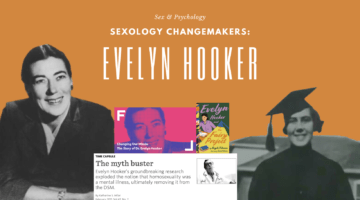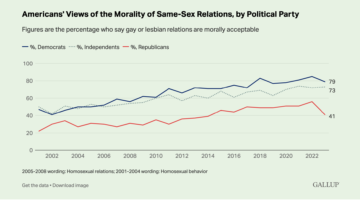Ten Myths About Sexual Orientation, Debunked By Science
June 10, 2016 by Justin Lehmiller

*In recognition of June being LGBT Pride Month, all of this week’s blog posts focus on LGBT issues.*
Despite all of the social progress made by sexual minorities in recent years, numerous stereotypes and misconceptions about sexual orientation persist. Below, I correct ten of the most common false beliefs and provide links to more detailed scientific information debunking them.
1.) Homosexuality is contagious through social contact. Research has failed to find support for the notion that same sex attraction is socially transmitted. For example, a recent, large-scale study found that same-sex attraction does not spread within adolescent peer groups. Likewise, other research has found that gay parents are no more likely to raise gay children than their heterosexual counterparts.
2.) You can “pray the gay away.” Research on adults who have attempted to change their sexual orientation–whether through religion or other means–finds that such treatments are generally ineffective and often do more harm than good.
3.) Most crossdressers are gay men. Many people believe that being gay means getting off on dressing up as member of the other sex (i.e., crossdressing/transvestism). While this may be true in some cases, the broader generalization is incorrect. Homosexuality simply means having an attraction to members of the same sex and says nothing about one’s interest in crossdressing. In fact, as it turns out, research has actually found that most crossdressers are heterosexual, married men.
4.) Lesbians have a lot less sex than everyone else. The concept of “lesbian bed death” has been around for decades, but it’s time we put it to bed. Although studies have found that lesbian couples do tend to have sex less often than other types of couples, sexual frequency doesn’t tell us everything. When lesbians have sex, they spend more time on it than everyone else. Moreover, research finds that lesbian couples are no less sexually satisfied than other couples.
5.) Bisexuals are just gays who haven’t come out yet. This is a belief that many people–both heterosexual and gay–hold, but it isn’t true. Of course you can find examples of people who have said they were bisexual because they weren’t quite ready to come out as gay, but this shouldn’t invalidate the sexual identities of anyone who says they are bisexual. See here and here for research supporting the idea that bisexuality is indeed a distinct sexual orientation.
6.) Being bisexual means you’re equally attracted to men and women. Being bisexual involves a capacity for attraction to men and women, but attraction to each does not necessarily have to be equally strong. For instance, research has found that bisexual men usually demonstrate more genital arousal to one sex over the other, although the direction of the effect is inconsistent (i.e., some show more arousal to women, others to men). Research on bisexual women has found that they don’t exhibit equal levels of arousal to men and women either. Some bisexual persons may indeed experience equally high levels of attraction, but equal attraction is neither an essential nor defining feature of bisexuality.
7.) Anal sex is the most common sexual behavior among gay men. Although there is a common tendency to conflate “anal sex” with “gay sex,” this doesn’t match up with reality. Research finds that oral sex and mutual masturbation are far more common among men who have sex with men. Not only that, but anal sex has actually become quite common among heterosexuals–it’s not a behavior limited to people of any one sexual orientation.
8.) All lesbians do is “scissor.” Locking legs like a pair of scissors and rubbing vulvas is something that some lesbians practice; however, not all of them do it. Furthermore, other sexual behaviors actually appear to be more common, including oral sex, fingering, and mutual masturbation.
9.) In same-sex couples, one partner is always the “husband” and the other is the “wife.”Although popular media depictions of same-sex couples tend to portray them as consisting of someone who plays the role of a traditional husband and someone who plays the role of a traditional wife, the fact of the matter is that same-sex couples are less likely to adopt these strict roles than their heterosexual counterparts. In fact, research finds that gay couples tend to share power and responsibilities equally.
10.) Same-sex parents aren’t as good as different-sex parents. The vast majority of research on parenting has found that children do just as well regardless of their parents’ sexual orientations. However, it is worth noting that one recent study–which found that adopted children’s outcomes were unrelated to parental sexual orientation–also revealed that same-sex parents tended to adopt higher-risk kids than their heterosexual counterparts. In light of this, a finding of no difference is quite a testament to the parenting qualities of same-sex couples.
Want to learn more about Sex and Psychology ? Click here for previous articles or follow the blog on Facebook (facebook.com/psychologyofsex), Twitter (@JustinLehmiller), or Reddit (reddit.com/r/psychologyofsex) to receive updates.
Image Source: iStockphoto
You Might Also Like:

Dr. Justin Lehmiller
Founder & Owner of Sex and PsychologyDr. Justin Lehmiller is a social psychologist and Research Fellow at The Kinsey Institute. He runs the Sex and Psychology blog and podcast and is author of the popular book Tell Me What You Want. Dr. Lehmiller is an award-winning educator, and a prolific researcher who has published more than 50 academic works.
Read full bio >


